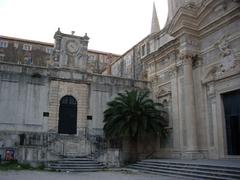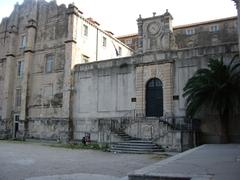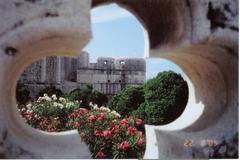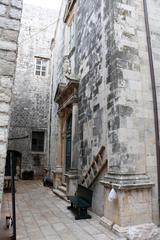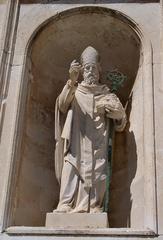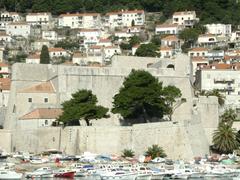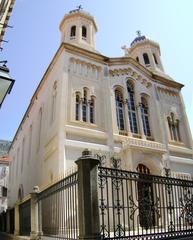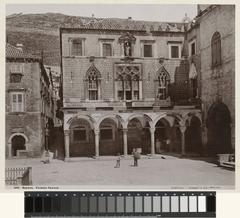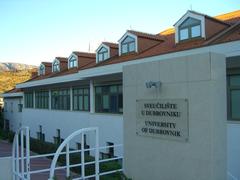
Diocesan Classical Gymnasium 'Ruđer Bošković' In Dubrovnik
Diocesan Classical Gymnasium Ruđer Bošković Dubrovnik: Visiting Hours, Tickets, and Historical Significance
Date: 14/06/2025
Introduction
The Diocesan Classical Gymnasium “Ruđer Bošković,” located in the heart of Dubrovnik’s UNESCO-listed Old Town, stands as a testament to Croatia’s enduring educational and cultural legacy. Established in the early 17th century during the Republic of Ragusa, this historic institution is renowned for its dedication to classical education, scientific exploration, and the fostering of humanistic values. Named after its most distinguished alumnus, Ruđer Bošković—a polymath whose pioneering work in physics, astronomy, and philosophy left a mark on European intellectual history—the gymnasium remains a symbol of tradition, learning, and cultural vibrancy (CaLiGraph resource, school website).
While the gymnasium primarily serves as an active secondary school, it occasionally opens its historic doors to the public during special events such as the “Night of Museums” and local heritage days. Its baroque and renaissance architecture, storied past, and role as a cultural hub make it a compelling destination for visitors eager to explore Dubrovnik’s academic and architectural treasures (Dubrovnik Tourist Board, Lonely Planet).
This guide details the evolution of the gymnasium, its educational philosophy, practical visitor information (including visiting hours, ticketing, and accessibility), and offers travel tips for making the most of your visit. It also highlights nearby attractions to help you plan a culturally rich Dubrovnik itinerary (Frank About Croatia, Chasing the Donkey).
Historical Background and Evolution
Foundation and Early History
Founded in the early 1600s under the auspices of the Roman Catholic Diocese during the Republic of Ragusa, the Diocesan Classical Gymnasium “Ruđer Bošković” adopted the Jesuit educational model, which emphasized Latin, Greek, philosophy, and theology. Its mission was to cultivate future leaders in humanities, law, priesthood, and public administration (CaLiGraph resource).
Enlightenment and Ruđer Bošković
The gymnasium’s most celebrated alumnus, Ruđer Bošković (1711–1787), emerged as a leading figure in physics, astronomy, and philosophy. His time at the school laid the foundation for his later scientific achievements, including significant contributions to atomic theory and optics. During the Enlightenment, the gymnasium broadened its curriculum to include modern languages and sciences, evolving into a center for intellectual and scientific advancement.
19th and 20th Century Developments
As political tides shifted—first under the Austrian Empire and later within Yugoslavia—the gymnasium adapted, adding mathematics, history, and geography. It played a crucial role in the Croatian national revival, nurturing language and culture through student societies. Despite the devastations of World War II and the Croatian War of Independence, the school maintained its classical focus and operated even during the siege of Dubrovnik, symbolizing resilience and the value of education (Dubrovnik Travel, Lonely Planet).
Architectural Evolution and Campus
The gymnasium occupies a baroque and renaissance complex, originally established by the Jesuits, featuring stone facades, arched windows, and a central courtyard. It is situated steps from the Jesuit Stairs and the Church of St. Ignatius, both architectural and cultural highlights of Dubrovnik’s Old Town (Dubrovnik Tourist Board).
The building, part of the historic Collegium Ragusinum, helped lay the groundwork for the modern University of Dubrovnik and remains visually integrated with surrounding landmarks (Wikiwand).
Academic Excellence and Community Impact
The curriculum, rooted in the classical tradition, focuses on Latin, Ancient Greek, philosophy, and humanities. The school’s emphasis on critical thinking and interdisciplinary learning is evident in alumni achievements in science, the arts, and public life. Students regularly participate in national and international competitions, such as the European Certificate for Classics (school news, Dec 2024).
The gymnasium also engages in civic events, cultural festivals, and collaborates with local institutions, reinforcing its role as a cornerstone of Dubrovnik’s intellectual and cultural community (school news, Nov-Dec 2024).
Visiting the Diocesan Classical Gymnasium Ruđer Bošković: Practical Information
Location and Access
The gymnasium is centrally located in Dubrovnik’s Old Town, adjacent to the Jesuit Stairs and the Church of St. Ignatius (RouteYou). The Old Town is pedestrianized; access is via Pile or Ploče gates, a 10-minute walk to the school. Public transport and taxis stop outside the city walls.
Visiting Hours and Tickets
As an active secondary school, regular visitor access to the interior is not available. The building opens to the public only during special events (e.g., “Night of Museums,” open days, educational fairs). During these times, admission is usually free, though some guided tours may require a small fee. Always check the school’s website or contact administration in advance to confirm availability (school contact).
Accessibility
Due to its historical architecture, the building has limited accessibility for visitors with mobility challenges. The Old Town’s cobblestone streets and the steep Jesuit Stairs may also present difficulties (Chasing the Donkey).
Guided Tours
Guided tours are offered by arrangement, primarily during special events or open days. Inquiries should be directed to the school or through the Dubrovnik Tourist Board (Dubrovnik Tourist Board).
Visitor Experience and Surroundings
While interior access is limited, the gymnasium’s exterior, the Jesuit Stairs, and the Church of St. Ignatius are freely accessible and among the city’s most photogenic locations. The area is lively, with nearby cafes (such as the Rudjer restaurant) offering a peaceful respite amidst the city’s bustle (Fathom Away).
Combine your visit with a stroll along the Old Town walls, the Rector’s Palace, and explore artisan shops and galleries to enrich your Dubrovnik experience (Frank About Croatia).
Practical Tips for Tourists
- Best Time to Visit: Early mornings and late afternoons (outside cruise ship hours) for fewer crowds and better light (The Scrapbook of Life). May, September, and October are ideal for milder weather.
- Footwear: Wear comfortable, non-slip shoes for navigating cobblestones and stairs.
- Photography: The exterior and complex are excellent photo spots, but be respectful of students and staff.
- Dining: The Rudjer restaurant next door is highly recommended for local cuisine and ambiance.
- Safety: Dubrovnik is safe, but keep an eye on valuables in crowded areas. Bring water and sun protection in summer.
FAQs
Q: Can I visit the Diocesan Classical Gymnasium Ruđer Bošković year-round?
A: Interior access is limited to special events and open days. The exterior and surrounding area are always accessible.
Q: Are tickets required?
A: No tickets are needed except for certain guided tours or events.
Q: Is the site accessible for people with disabilities?
A: Limited; the building and surrounding area have stairs and uneven pavement.
Q: How do I get there from the Old Town gates?
A: Walk from Pile or Ploče gate; the gymnasium is near the Jesuit Stairs.
Q: Can I arrange a guided tour?
A: Yes, by contacting the school or tourist board, especially during events.
Cultural and Educational Significance
The Diocesan Classical Gymnasium “Ruđer Bošković” is a living testament to Dubrovnik’s classical education heritage and its historic bond with the Catholic Church (Wikipedia). Its alumni have shaped regional and European culture, science, and public life, making the institution a pillar of the city’s identity.
Summary
The Diocesan Classical Gymnasium “Ruđer Bošković” offers visitors a unique window into Dubrovnik’s academic traditions and architectural splendor. Though regular interior access is limited, its location in the Old Town, proximity to major landmarks, and occasional open events make it a worthwhile stop for culture and history enthusiasts. Plan your visit during special events for a chance to explore inside, and combine your tour with nearby attractions to capture the essence of Dubrovnik’s UNESCO World Heritage charm (Wikipedia, UniCath, Dubrovnik Travel, Frank About Croatia).
Visuals and Media Suggestions
- Use images of the gymnasium’s facade, interior courtyard, and the Jesuit Stairs with descriptive alt texts.
- Provide location maps showing proximity to Dubrovnik’s major landmarks.
- Offer virtual tour links if available.
Plan Your Visit and Stay Connected
For updated information on opening hours, events, and tours, consult the school’s official website, the Dubrovnik Tourist Board, or download the Audiala app for guided tours and notifications. Follow Dubrovnik’s cultural channels for the latest news and recommendations.
References
- CaLiGraph resource
- school website
- RouteYou
- Dubrovnik Tourist Board
- Lonely Planet
- Chasing the Donkey
- Frank About Croatia
- UniCath
- Wikipedia
- Dubrovnik Travel
- Fathom Away
- The Scrapbook of Life
- Wikiwand
